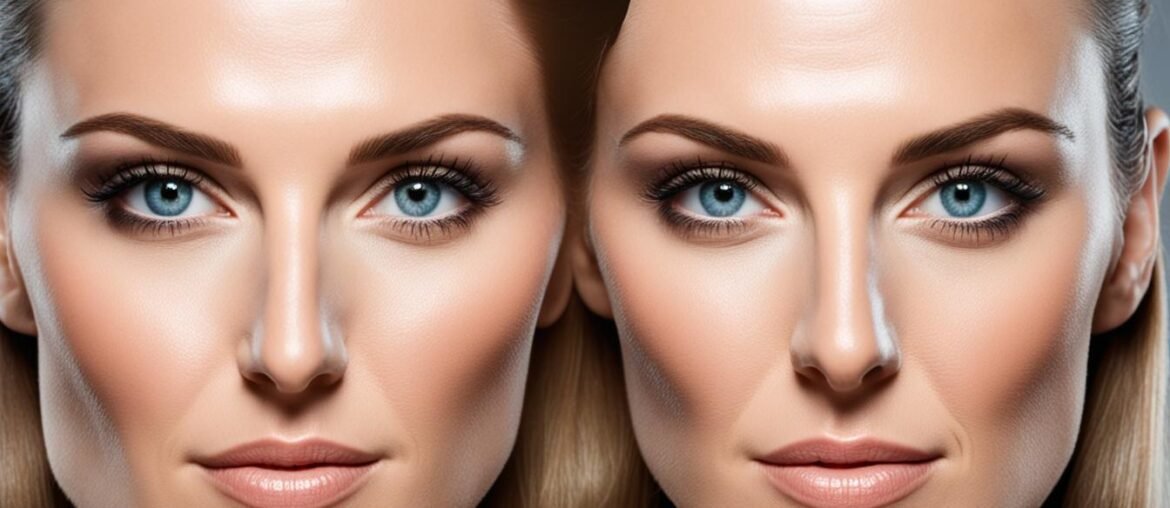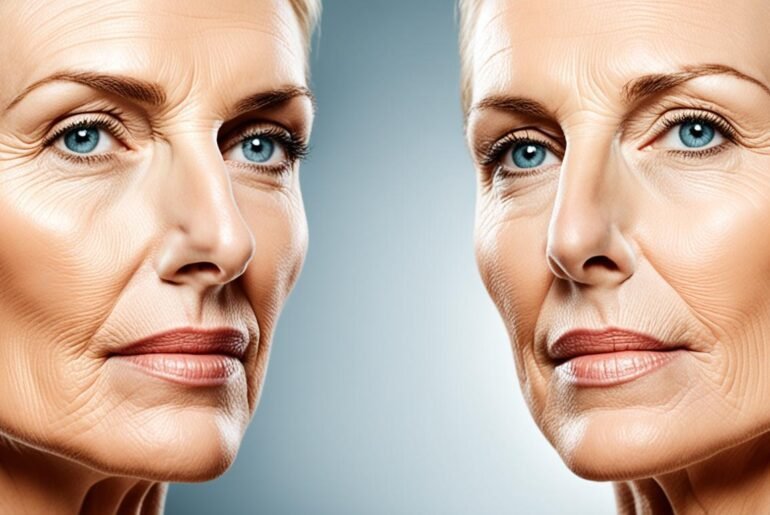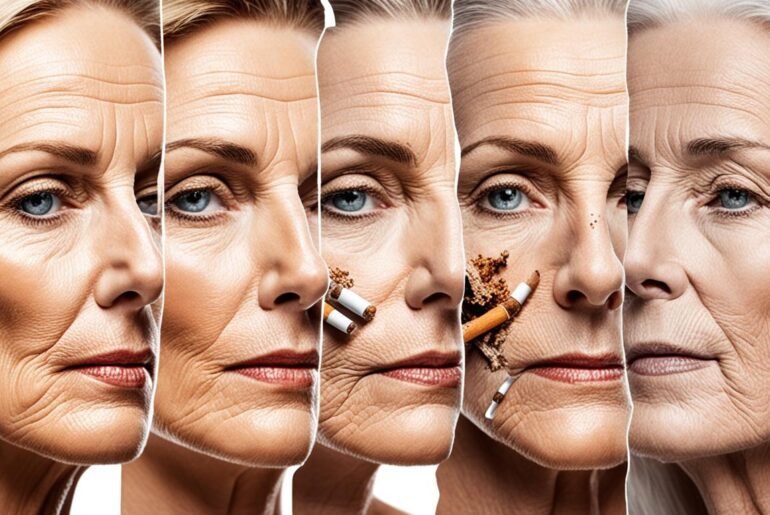Did you know that smoking not only harms your lungs and heart, but it also accelerates the aging process of your skin? The chemicals in cigarettes can cause long-term damage to your skin, resulting in wrinkles, sagging, dryness, and even skin cancer. However, there is hope for rejuvenating your skin and slowing down the signs of aging by quitting smoking.
The Negative Impact Of Smoking On Skin Health
Smoking has a detrimental effect on skin health, subjecting the body to a range of toxins that hinder the absorption of vital oxygen, vitamins, and nutrients. The chemicals present in cigarettes can cause a multitude of skin issues, including a loss of healthy color, dryness, sagging, lines and wrinkles, warts, age spots, and even an increased risk of skin cancer. Additionally, chronic smokers may find themselves disqualified from certain plastic surgery procedures due to the negative impact smoking has on the skin’s healing process. It is imperative to understand the profound consequences that smoking can have on the health and appearance of the skin.
“The chemicals present in cigarettes can cause a multitude of skin issues, including a loss of healthy color, dryness, sagging, lines and wrinkles, warts, age spots, and even an increased risk of skin cancer.”
Loss of Healthy Color
One of the visible effects of smoking on the skin is the loss of healthy color. Smoking causes the smallest blood vessels in the skin to constrict, reducing blood flow and resulting in a pale, grayish complexion. The lack of proper blood circulation deprives the skin of oxygen and essential nutrients, leading to a dull and lifeless appearance.
Dryness and Sagging
The chemicals in cigarettes can also have a drying effect on the skin, leading to increased dryness and a lack of natural moisture. This can result in a rough and dehydrated complexion. Moreover, smoking damages collagen and elastin fibers in the skin, causing it to lose its elasticity and firmness, leading to sagging and a prematurely aged appearance.
Lines and Wrinkles
Smoking accelerates the aging process by breaking down collagen and elastin, which are essential for maintaining the skin’s structure and elasticity. As a result, smokers are more prone to developing fine lines, deep wrinkles, and crow’s feet at an earlier age compared to non-smokers. The repetitive facial motions of smoking, such as pursing the lips and squinting the eyes, also contribute to the formation of dynamic wrinkles.
Warts and Age Spots
Smoking compromises the immune system, making the skin more susceptible to infections, viruses, and the development of warts. Furthermore, the toxic chemicals in cigarettes can cause an uneven distribution of melanin, resulting in the formation of age spots or dark patches on the skin, especially in sun-exposed areas.
Increased Risk of Skin Cancer
Perhaps the most alarming consequence of smoking on skin health is the increased risk of developing skin cancer. The toxic substances present in tobacco smoke can damage DNA and impair the skin’s ability to repair itself, making it more susceptible to the development of various types of skin cancer, including melanoma.
| Effects of Smoking | Consequences on Skin Health |
|---|---|
| Loss of healthy color | Pale, grayish complexion |
| Dryness and sagging | Rough, dehydrated skin with decreased elasticity |
| Lines and wrinkles | Premature formation of fine lines and deep wrinkles |
| Warts and age spots | Increased susceptibility to viral infections and uneven pigmentation |
| Increased risk of skin cancer | Greater likelihood of developing various types of skin cancer, including melanoma |
How Skin Repairs Itself After You Quit Smoking
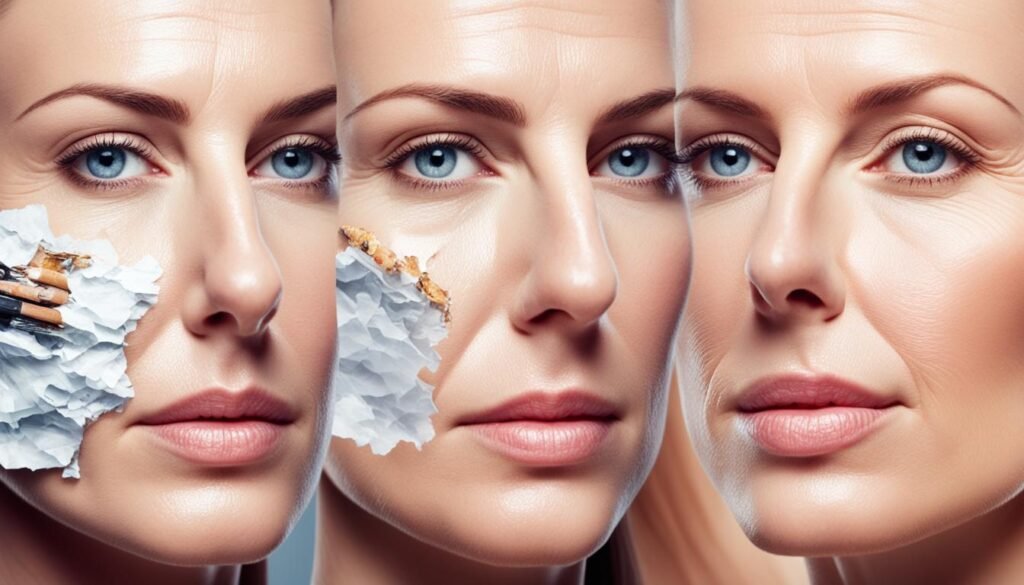
Quitting smoking not only benefits your overall health but also has a positive impact on your skin. Let’s explore how your skin repairs itself after you quit smoking.
First and foremost, quitting smoking leads to a significant improvement in blood flow throughout your body. As a result, more oxygen and essential nutrients reach your skin cells, aiding in the repair and rejuvenation process. This increased blood flow also helps remove toxins from your skin, giving it a healthier appearance.
When you quit smoking, the levels of carbon monoxide in your body decrease. Carbon monoxide is a harmful gas that reduces the amount of oxygen your blood can carry. With lower levels of carbon monoxide, your skin receives an adequate supply of oxygen, which is essential for healthy and vibrant-looking skin.
Additionally, quitting smoking allows your body to produce more antioxidants. Antioxidants are powerful compounds that help protect your skin from free radicals, which can cause damage and accelerate the aging process. With an increased supply of antioxidants, your skin becomes more resilient and better equipped to combat environmental stressors.
Furthermore, quitting smoking promotes the production of new skin cells. The healthy cellular turnover that occurs after quitting helps to replace damaged cells with fresh, vibrant ones. As a result, your skin texture improves, and you may notice a youthful glow.
One of the key benefits of quitting smoking is the restoration of collagen production. Collagen is a protein that provides structure and elasticity to your skin. Smoking accelerates the breakdown of collagen, leading to wrinkles and sagging. However, when you quit smoking, collagen production is restored, reducing the appearance of wrinkles and improving skin firmness.
Quitting smoking early in life can have even more significant effects on skin repair and treatment. The sooner you quit, the faster your skin can recover from the damage caused by smoking. Wrinkles may be more responsive to treatments, and overall skin repair may be more noticeable.
In conclusion, quitting smoking allows your skin to repair itself and regain its natural beauty. Increased blood flow, reduced carbon monoxide levels, improved oxygen supply, and enhanced antioxidant production all contribute to improved skin appearance and resistance to aging. Quitting smoking is a crucial step towards achieving healthier and more vibrant skin.
Healthy Color Returns
Smoking takes a toll on the skin, causing the smallest blood vessels to constrict and resulting in a dull, grayish complexion. The negative effects of smoking can be reversed, and one of the first noticeable changes is the return of healthy color to the face.
When a person quits smoking, their circulation improves, allowing for better blood flow to the skin. The increased blood flow brings oxygen and essential nutrients, revitalizing the complexion and restoring its natural radiance. Within just 24 hours of quitting smoking, the face regains its healthy glow and color.
Quitting smoking not only improves the appearance of the skin but also contributes to overall skin health. With better blood circulation and oxygenation, the skin becomes more resilient, capable of repairing damage and defending against external aggressors.
If you’re looking to restore a vibrant, healthy complexion, quitting smoking is a crucial step in the right direction.
“Quitting smoking rejuvenates the skin, allowing it to heal and restore its natural healthy color.”
Further Damage is Prevented
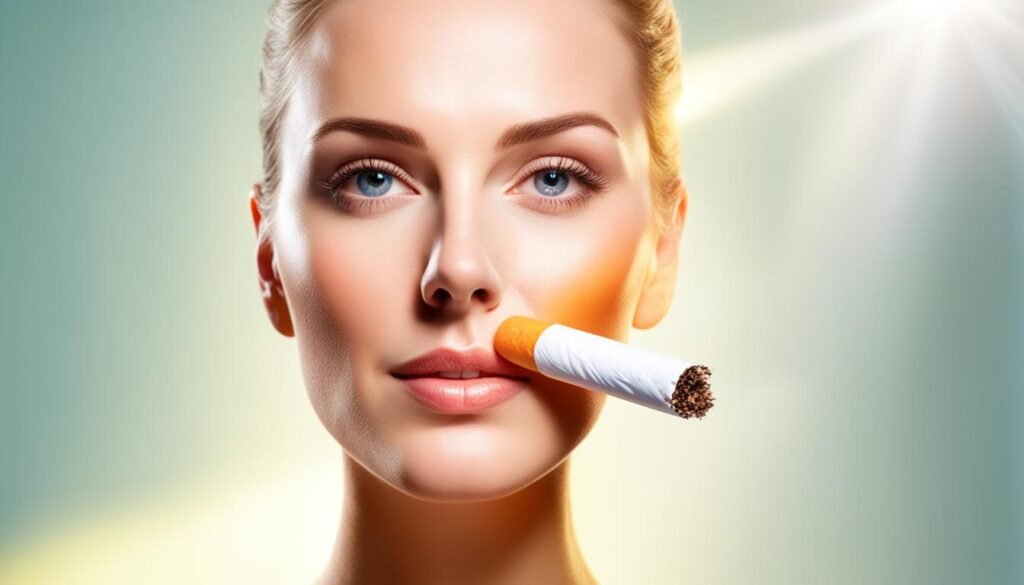
Smoking can lead to wrinkles due to repeated puckering and a deficiency of nutrients and oxygen. The earlier a person quits smoking, the more repairable and treatable these wrinkles are. Delaying quitting can result in static wrinkles that are more difficult to treat.
Quitting smoking not only helps to prevent further skin damage but also offers the opportunity for existing damage to be repaired. By quitting smoking early, individuals can reverse the effects of wrinkles caused by repetitive facial movements and the lack of essential nutrients and oxygen.
“The earlier a person quits smoking, the more repairable and treatable these wrinkles are.”
When smoking is ceased promptly, the skin’s natural healing processes can kickstart, promoting the restoration and rejuvenation of damaged skin cells. This ultimately leads to a smoother, more youthful complexion by preventing the progression of wrinkles and other signs of aging.
Benefits to Your Skin After Quitting Smoking
Quitting smoking is not only beneficial for your overall health, but it can also have a positive impact on the condition of your skin. By ditching this harmful habit, you’ll experience a range of benefits that will improve the appearance and health of your skin.
- Slowing down of the aging process: Smoking accelerates the aging of your skin, causing premature wrinkles, fine lines, and sagging. When you quit smoking, you slow down this aging process, giving your skin a chance to heal and rejuvenate.
- Increased skin cell turnover: Smoking restricts blood flow to the skin, leading to a dull complexion and slow healing of wounds. Once you quit smoking, your skin’s cell turnover improves, resulting in a fresher and more vibrant appearance.
- Reduction in discoloration and staining: Chemicals in cigarettes can cause skin discoloration, making your complexion appear uneven and dull. Quitting smoking helps reduce these stains and discolorations, allowing your natural skin tone to shine through.
- Prevention of further damage: Smoking not only damages skin cells but also weakens the skin’s natural defense mechanisms. By quitting smoking, you protect your skin from further harm, decreasing the risk of developing serious skin conditions such as skin cancer, psoriasis, and acne.
Overall, quitting smoking is a powerful step towards improving the health and appearance of your skin. It’s never too late to make a positive change and give your skin the chance to renew and replenish itself.
Slowing of the Ageing Process
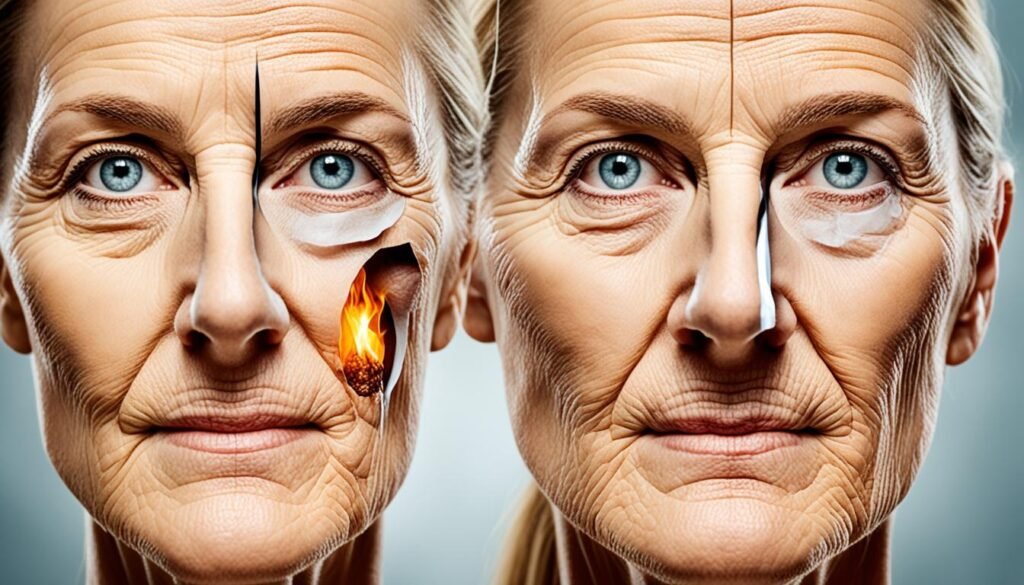
Although existing wrinkles may not disappear completely, quitting smoking has significant positive effects on the skin’s ageing process. When you quit smoking, your skin undergoes a rejuvenation process, leading to improved skin quality.
Collagen, which provides elasticity and firmness to the skin, starts to renew itself after quitting smoking. This increased collagen production helps reduce the appearance of wrinkles and fine lines, giving your skin a more youthful and smoother appearance.
In addition to collagen, elastin, which allows the skin to stretch and regain its shape, also replenishes itself after quitting smoking. This leads to improved skin elasticity, making it more resistant to sagging and the formation of new wrinkles.
By quitting smoking, you give your skin a chance to repair and restore itself, slowing down the ageing process and promoting a healthier overall complexion.
Benefits of Quitting Smoking on the Skin’s Ageing Process
| Benefits | Description |
|---|---|
| Improved collagen production | Reduce the appearance of wrinkles and fine lines |
| Renewed elastin | Enhance skin elasticity and firmness |
| Slowed ageing process | Delay the formation of new wrinkles and sagging |
Increased Skin Cell Turnover

When you quit smoking, you give your skin the opportunity to repair itself and undergo increased skin cell turnover. This is a crucial process that helps reduce the appearance of wrinkles and fine lines, while also promoting the healing of wounds and scars. Increased skin cell turnover means that new, healthy skin cells are produced at a faster rate, replacing the damaged and aging cells.
As a result, your skin becomes smoother, more radiant, and more resilient. The increased production of new skin cells helps to improve the overall texture and tone of your skin, giving it a youthful and refreshed appearance.
By quitting smoking, you allow your skin to regenerate and renew itself, reversing the damage caused by years of smoking. The harmful chemicals in cigarettes can impede the natural process of skin cell turnover, leading to dull and aged-looking skin.
“Quitting smoking can have profound effects on the health and vitality of your skin. The increased skin cell turnover helps to restore and rejuvenate your complexion, giving you a fresh and youthful glow.”
By quitting smoking, you are not only improving your overall health but also taking a significant step towards achieving healthier and more vibrant skin.
| Benefits of Increased Skin Cell Turnover |
|---|
| Reduces the appearance of wrinkles and fine lines |
| Promotes the healing of wounds and scars |
| Improves the overall texture and tone of the skin |
| Enhances skin’s radiance and vitality |
| Reverses the damage caused by smoking |
Reduced Discolouration and Staining
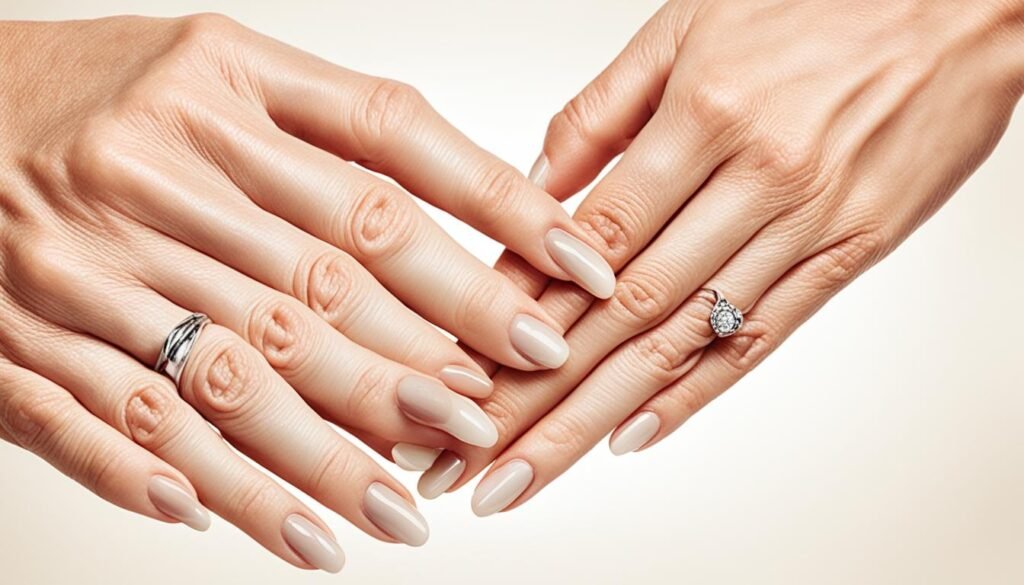
One of the visible effects of smoking on the skin is discoloration and staining. The harsh chemicals in cigarettes can lead to a dull, grayish complexion and leave unsightly marks on the skin. However, quitting smoking can help reduce these issues and restore a healthier, more radiant skin tone.
When you quit smoking, the increased blood flow to the skin brings back the natural color and brightness. The improved circulation helps to flush out toxins and deliver essential nutrients to the skin cells, promoting a more even complexion. Additionally, the oxygen-rich blood revitalizes the skin, reducing the appearance of grayness and paleness.
“Quitting smoking allows the skin to recover and rejuvenate, resulting in a reduction in discoloration and a brighter, healthier-looking complexion.”
This positive change in the skin’s appearance is often noticeable within a short period of time after quitting smoking. As the skin heals and regains its natural vitality, you may experience a new-found radiance and glow that reflects improved overall skin health.
It’s important to note that while quitting smoking can help reduce discoloration and staining, its effectiveness may vary based on individual circumstances. The extent of improvement may depend on factors such as the duration and intensity of smoking, as well as other lifestyle choices and skincare practices.
| Before Quitting Smoking | After Quitting Smoking | |
|---|---|---|
| Discoloration | Evident, dull complexion | Reduced, improved skin tone |
| Staining | Persistent marks, uneven skin | Diminished, more even skin texture |
By quitting smoking and embracing a healthier lifestyle, you give your skin the opportunity to heal and thrive. Consistent skincare, along with a balanced diet and regular exercise, can further enhance the benefits of quitting smoking and contribute to a more vibrant, youthful complexion.
Restores Collagen Production

When it comes to smoking, one of the most harmful effects on the skin is its impact on collagen production. Collagen is a protein responsible for the skin’s structure, elasticity, and overall youthfulness. Unfortunately, smoking impairs collagen production, leading to sagging skin, wrinkles, and a loss of firmness.
However, there is good news for those who quit smoking. The restoration of collagen production is possible after quitting smoking, allowing the skin to heal and rejuvenate itself. Once you quit smoking, the body can reactivate collagen production, resulting in improved skin elasticity and appearance.
Collagen rejuvenation plays a crucial role in reducing fine lines and wrinkles, enhancing the skin’s plumpness, and restoring a more youthful complexion. With increased collagen production, the skin becomes firmer, smoother, and more resilient. Quitting smoking is a vital step towards giving your skin the chance to repair and regenerate.
Quitting smoking not only benefits the skin’s collagen production but also promotes overall skin health. The improved blood flow and oxygenation that accompany smoking cessation provide the skin with essential nutrients and promote a healthier complexion. By kicking the smoking habit, you can restore collagen production and give your skin a new lease on life.
Conclusion
Quitting smoking can have significant positive effects on the skin. By eliminating the harmful chemicals found in cigarettes, individuals can experience a range of benefits that contribute to overall skin improvement. One of the key advantages of quitting smoking is the improvement of complexion. Increased blood flow, resulting from healthier circulation, leads to a brighter and more vibrant appearance, replacing the pale and grayish complexion often associated with smokers.
In addition to a healthier complexion, quitting smoking can also reduce the signs of aging. The skin’s ability to produce collagen is restored, resulting in improved elasticity and reduced appearance of wrinkles and sagging. Furthermore, increased skin cell turnover allows for better healing of wounds and scars, promoting a more youthful and rejuvenated look.
While quitting smoking can reverse some of the damage caused by tobacco use, it is important to note that existing wrinkles may not completely disappear. However, by adopting a holistic approach to skincare, including a healthy diet, regular exercise, and proper skincare practices, individuals can further enhance the improvement of their skin. Quitting smoking is undoubtedly a crucial step in achieving healthier and more radiant skin.
FAQ
Does quitting smoking improve skin aging?
Yes, quitting smoking can improve skin aging. Smoking exposes the skin to toxins that can cause various skin issues such as dryness, sagging, lines, wrinkles, and even skin cancer. Quitting smoking allows the skin to repair itself, leading to improved skin appearance, resistance to environmental damage, and a youthful glow. Collagen production is also restored, reducing wrinkles and sagging.
What is the negative impact of smoking on skin health?
Smoking can have a detrimental effect on the health of the skin. Exposure to the chemicals in cigarettes can result in long-term skin disorders and early onset aging symptoms. It can cause loss of healthy color, dryness, sagging, lines and wrinkles, warts, age spots, and even skin cancer. Chronic smokers may also be disqualified from plastic surgery procedures.
How does the skin repair itself after you quit smoking?
When you quit smoking, the skin starts to repair itself. Blood flow increases, carbon monoxide levels drop, and oxygen, antioxidants, and new skin cell production return to normal. This leads to improved skin appearance, resistance to environmental damage, and a youthful glow. Collagen production is also restored, reducing wrinkles and sagging.
Does healthy color return to the skin after quitting smoking?
Yes, when a person quits smoking, circulation improves, oxygen becomes more readily available, and healthy color returns to the face within 24 hours. Smoking causes the smallest blood vessels in the skin to shut down, resulting in a pale, grayish complexion. Quitting smoking helps restore a healthy color and brightness to the skin.
Can quitting smoking prevent further damage to the skin?
Yes, quitting smoking can prevent further damage to the skin. Smoking exposes the body to toxins that hinder the absorption of oxygen, vitamins, and nutrients, leading to skin issues and premature aging. By quitting smoking, you reduce the risks associated with smoking and allow your skin to heal and rejuvenate.
What are the benefits to your skin after quitting smoking?
Quitting smoking has several benefits for the skin. It slows down the aging process, increases skin cell turnover, reduces discoloration and staining, and prevents further damage. It also decreases the risk of developing serious skin conditions such as skin cancer, psoriasis, and acne. Quitting smoking allows the skin to repair itself and improves overall skin health.
Does quitting smoking slow down the aging process?
Yes, quitting smoking can slow down the aging process. Smoking accelerates the aging of the skin due to the toxins and chemicals in cigarettes. By quitting smoking, you allow your skin to repair itself and restore collagen production, reducing the appearance of wrinkles and sagging.
How does quitting smoking increase skin cell turnover?
Quitting smoking allows the skin to repair itself and increases skin cell turnover. This helps reduce the appearance of wrinkles and improves the skin’s ability to heal wounds and scars. Increased blood flow after quitting smoking improves complexion and reduces grayness and paleness in the skin.
Can quitting smoking reduce discoloration and staining on the skin?
Yes, quitting smoking can reduce discoloration and staining on the skin. Smoking can cause the skin to appear dull, discolored, and stained. By quitting smoking, the skin’s ability to heal and renew itself improves, leading to a reduction in discoloration and staining.
How does quitting smoking restore collagen production?
Smoking impairs collagen production, but this process can be restored after quitting smoking. Reactivation of collagen production occurs in the body, leading to improved skin elasticity and appearance. Quitting smoking allows the body to repair and rejuvenate the skin, including the production of essential proteins like collagen.
What is the conclusion on how quitting smoking improves skin aging?
Quitting smoking can have significant positive effects on the skin. It improves skin aging by slowing down the aging process, increasing skin cell turnover, reducing discoloration and staining, and restoring collagen production. However, it is important to note that while quitting smoking can reverse some damage, it may not completely eliminate existing wrinkles. Other factors such as a healthy diet, regular exercise, and proper skincare can also contribute to skin improvement.

